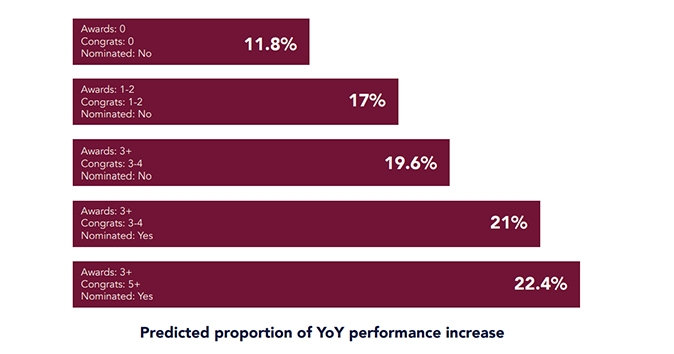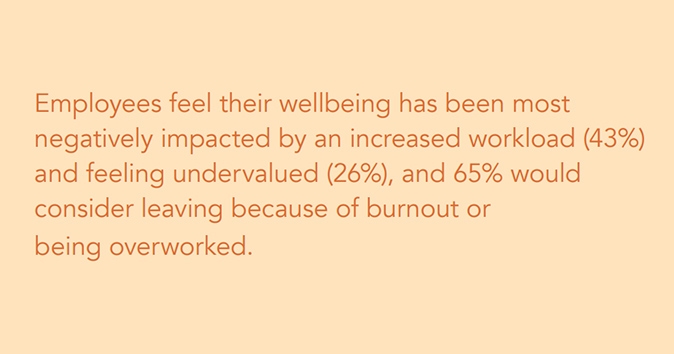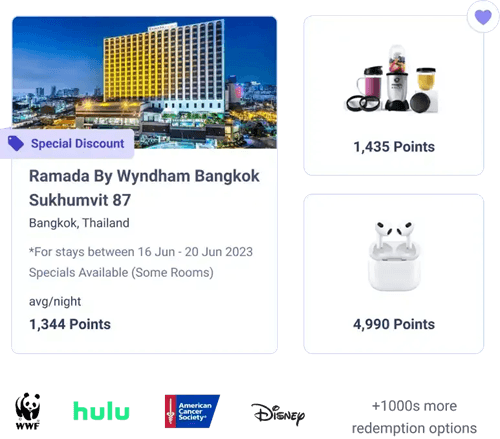41 Ideas for Employee Rewards: Boosting Morale and Productivity

Employee rewards are no longer nice-to-have perks in the modern workplace. Instead, a rewards program has become a strategic “must-have” to attract, engage, and retain employees.
Read on to learn fun and creative ideas for employee rewards.
What are employee rewards?
Employee rewards are gifts or awards to celebrate your employees’ great work, milestones, achievements, or contributions to the company. Rewards like employee recognition strengthen the bond between employees and your organization.
Why are employee rewards important?
The benefits of employee rewards go beyond improving the employee experience – they will improve your bottom line as well. Let’s talk through some of the main benefits of implementing employee rewards.

Boost morale
Showing appreciation for your employees boosts their morale and self-esteem. Feeling valued increases their motivation to excel in their roles. And high morale leads to a happier and more productive workforce.
Improve productivity
Incentives can help reinforce positive behaviors and outcomes. Employees who feel rewarded for their accomplishments are more likely to maintain or exceed their productivity levels. In turn, it benefits the organization by driving higher efficiency and performance.
Support DEI efforts
Workhuman® and Gallup® research has found that employees who strongly agree that they receive the right amount of recognition for the work they do are four times as likely to perceive their workplace as inclusive and seven times more likely to perceive it as equitable compared to those who don’t receive the right amount of recognition.
Find out how Recognition data can take your DEI strategy to new heights.
Additionally, the research shows Black and Hispanic employees who strongly agree they receive fulfilling recognition are 26% less likely to be actively searching or watching for another job compared to those who do not strongly agree.
Increase retention
Employee turnover is costly and disruptive. According to the Society for Human Resource Management, businesses spend six to nine timesOpens in a new tab an employee’s salary to replace them.
Employee recognition and rewards programs can help reduce turnover rates by creating a positive work environment where employees feel valued and motivated to stay.
Ease burnout
Workhuman and Gallup research shows Black and Hispanic employees who strongly agree that they are receiving the right amount of recognition are 43% and 44% less likely to be burned out, respectively, than those who do not strongly agree.

Attention leaders! Do you want to improve employee wellbeing and drive business success? Discover how strategic recognition can help in the Workhuman and Gallup report:
Learn how recognition can improve engagement, reduce burnout, and increase company loyalty, resulting in clear ROI.
*The report examines a large-scale study of over 12,000 employees across 12 countries and uncovers the connection between recognition and wellbeing in each region.
* Take action to improve employee wellbeing today!
What makes an employee reward program successful?
Gallup defines the "five pillars of strategic recognition" as follows:
- Fulfilling: It feels appropriate to the accomplishment
- Authentic: It feels genuine rather than a formality
- Personalized: It's the way someone wants to be recognized
- Equitable: It's about achievement, not favoritism
- Embedded in company culture: It's part of the values and practices throughout the organization
There are two main types of rewards to motivate and engage your people: monetary and non-monetary rewards.
Monetary rewards include:
- Redeemable points (for example, at Workhuman you can redeem your recognition points for anything from vacations to gift cards)

- Pay raises
- Commissions
- Employee stock options
- Profit-sharing
- Performance-based bonuses
- Loyalty bonuses
Workhuman research has found Social Recognition, which combines messages of appreciation with monetary rewards, is 20% more effective than non-monetary recognition when looking at reducing turnover.
See how recognition can positively impact your workforce by downloading Workhuman's report "Thanks, but No E-thanks."
Non-monetary rewards include:
- Fringe benefits (e.g., workplace perks, employee discounts, educational assistance, wellness programs, etc.)
- Receiving gifts
- E-thanks
- Extra days off
- Company outings
Creative rewards and recognition ideas
There are endless ways to show your employees you care. Here’s an exhaustive list of employee recognition ideas to incorporate into your performance management strategy:
Personal rewards
These thoughtful perks promote a positive work culture that celebrates individuality. Below are some examples of personal employee rewards.
1. Employee recognition program

An employee recognition program streamlines the process of giving out rewards and recognition while nurturing a positive work culture.
Social Recognition® allows you to thank and reward anyone anywhere in the organization with just a few taps.
Below are some features you may find in popular recognition platforms:
- Peer-to-peer recognition
- Points redemption for tangible rewards
- Customizable performance awards
- Automated milestone celebrations (e.g., work anniversaries and birthdays)
2. Gift cards
Gift cards are a popular and versatile choice for employee rewards. They come in various forms, such as physical cards or digital codes. Employees can use them for a wide range of purchases, from shopping and dining to entertainment and travel.
3. Mindfulness app subscription
A subscription to a mindfulness app like Headspace can help employees find tranquility amid busy workdays. It promotes mental wellbeing and helps employees stay centered in a fast-paced environment.
4. Subsidized commute
Whether it’s public transportation, gas money, or rideshare services, subsidizing commuting expenses shows you care about employees' comfort and convenience.
5. Tickets to “that thing they love”
Surprise employees with tickets to a long-awaited concert, sporting event, or theater show. It’s a fantastic way to connect with their interests and create unforgettable memories.
6. Car maintenance
Offer to cover a car maintenance service. A well-maintained vehicle keeps your employees safer on the road.
7. Time off
Give employees the gift of time. How about an extra day off to escape the daily grind and enjoy some well-deserved rest?
8. Laundry services
Arrange for laundry services or a dry cleaning subscription. That’s one less thing to worry about while getting work done.
9. Gym membership
People who exercise have sharper memory and thinkingOpens in a new tab skills that help them in all facets of life. Encourage employees to stay active and healthy with a gym membership.
10. Personal trainer voucher
Book sessions with a personal trainer to kickstart employees' fitness journey. Personalized fitness guidance ensures they get the most out of their workouts.
11. Luxury spa treatment
Who doesn’t love a good pampering session? Arrange a spa day to treat your employees to various relaxation and wellness treatments.
12. Sponsor employees in an athletic event
Cover the expenses for them to participate in a marathon or other athletic event they’ve always wanted to try.
13. Spotlight in newsletter
Give your top performers a shoutout in your company newsletter. Share their achievements, experiences, and insights to inspire others on your team.
14. Local coffee club membership
Enroll employees in a local coffee club to ensure they always have their favorite brew in the morning. Or, pay for a subscription service to deliver fresh beans right to their doorstep.
For coffee enthusiasts, this is the gift that keeps giving – a daily dose of motivation and caffeine!
Employee development rewards
Using employee development rewards, you can invest in your employees’ growth and contribute to the organization’s long-term success.
1. Shadow somebody for the day
Allow employees to shadow another employee from a different department or role. This experience opens their eyes to what someone does in their job.
2. A personal note from the CEO
A handwritten note from the CEO is a simple way to convey heartfelt appreciation for a job well done. According to a McKinsey study, 67% of employees identified praise from bosses as a top performance motivator.
3. Pay for professional courses
Upskill your employees by covering the cost of professional courses or certifications related to the employee’s field.
4. Seminars and conferences
Sponsor employees to attend industry seminars, conferences, or workshops. Exposure to networking and collaboration opportunities can enhance their skills and professional development.
5. Memberships
Provide employees with memberships in relevant professional organizations or associations. It connects them with a broader community and updates them on industry trends.
6. Professional development books
Gift employees with books that are relevant to their career or personal development. The idea is to provide resources that help them succeed or prepare for future opportunities.
7. Hackathons
Organize hackathons or innovation challenges that allow employees to work on creative projects outside their usual roles. These events promote teamwork as employees often work in small groups or teams to achieve a common goal.
8. Financial advisor session
Financial wellness has direct links to happiness and a sense of security. Provide employees with one-on-one sessions with a financial advisor to help them plan for their financial future.
9. Lunch and learn sessions
Host regular “lunch and learn” sessions where employees can share their expertise over food. It encourages knowledge-sharing and continuous learning within your teams.
Team rewards
Here’s a list of employee recognition examples to motivate your team:
1. Monthly book subscription
Provide your team with a monthly book subscription, allowing them to explore new worlds and ideas. It encourages reading and sparks thoughtful discussions. It might even inspire the team to create a book club.
2. Pay into a team “fun” budget
While work is essential, taking time for enjoyable and team-building activities can improve employee engagement. Allocate a budget specifically for this.
3. Open a pick-and-mix stand
Set up a pick-and-mix stand stocked with a variety of snacks and treats in the office. It’s a sweet way to keep energy levels high and encourage impromptu team gatherings.
4. Local restaurant experience
Treat your team to a meal at a restaurant around the block and bond over good food. It’s an opportunity to explore the local food scene while enjoying each other’s company.
5. Professional cooking class
Enroll your team in a professional cooking class where they can learn to whip up gourmet dishes together. Cooking fosters creativity and collaboration as your team members join forces to create a delicious meal.
6. Wine tasting
Arrange a wine-tasting event at a local winery where your team can savor different wines and enhance their palates. It’s a fun and sophisticated way to relax, socialize, and appreciate the finer things in life.
7. Pottery class
Encourage your team to explore their creative side by attending a pottery class. Pottery is a therapeutic activity that can yield unique, handmade keepsakes.
8. Treasure hunt
Organize a thrilling treasure hunt around your workplace complete with clues and challenges. It promotes teamwork and problem-solving as the members combine efforts to uncover hidden treasures.
9. Start a bike share program
Initiate a bike share program where team members can borrow bicycles for leisure or commuting. It encourages physical activity, eco-friendliness, and team outings on two wheels.
10. Yoga class
Offer yoga sessions for your team to unwind, de-stress, and enhance their physical and mental wellbeing.
Yoga promotes relaxation, mindfulness, and team unity through shared wellness experiences.
Remote rewards
Employees who work from home may often grapple with isolation. So, here are some creative ideas for remote employees.
1. Workation (digital nomad)
A break from the routine can ease burnout. Book your employees a beachside villa or a room with a view where they can blend work with leisure.
Ready to say goodbye to employee burnout? Check out this white paper on Easing Employee Burnout.
2. Treat by mail
Surprise your remote team with personalized care packages sent to their doorstep. These packages could include snacks, self-care items, or company swag.
3. Fly-in workers from remote places
For important meetings or team-building events, consider flying remote employees to the main office or a central location. Face-to-face interactions can be invaluable for building strong relationships.
4. One-on-one mentoring
Connect remote employees with the leadership team for guidance, career advice, and support. This can help them feel more integrated into the company culture.
5. Personal chef
Give your remote workers a break from cooking by arranging for a personal chef to prepare meals for them periodically.
6. House cleaning
A study shows that cleanliness enhances an employee’s productivity. Arrange a professional house cleaning service to make your living space sparkling clean.
7. Tech gadgets allowance
Consider offering tech gadgets as gifts for remote workers by providing a budget to upgrade their home office equipment. Make sure they have the necessary tools to excel in their roles.
Conclusion
Employee rewards have become essential tools for organizations to thrive. They boost employee engagement, cultivate a positive work culture, and contribute to the success of the company.
So, don’t wait – the time is now to implement these ideas for employee rewards.